3D-TV, Automated Cooking and Robot Housemaids: Walter Cronkite Tours the Home of 2001
In 1967, the most trusted man in America investigated the home of the 21st century
/https://tf-cmsv2-smithsonianmag-media.s3.amazonaws.com/filer/20130129124130cronkite-470x251.jpg)
Legendary news anchor Walter Cronkite’s regular half-hour CBS documentary program “The 21st Century” was a glorious peek into the future. Every Sunday night viewers of the late 1960s were shown all the exciting technological advancements they could expect to see just 30 or 40 years down the road. The March 12, 1967, episode gave people a look at the home of the 21st century, complete with 3D television, molded on-demand serving dishes, videophones, inflatable furniture, satellite newspaper delivery and robot servants.
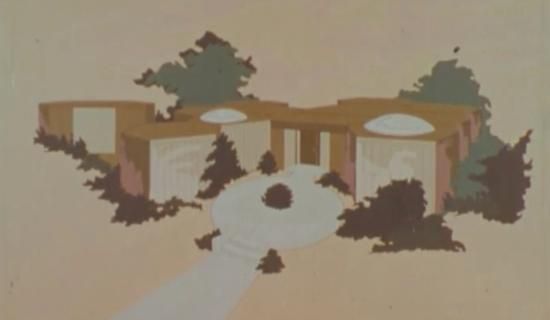
Cronkite spends the first five minutes of the program deriding the evils of urban sprawl and insisting that everyone dreams of a house in seclusion on a few acres of land. Cronkite and his interviewee Philip Johnson insist that moving back into ever denser cities is the wave of the future. It’s interesting then that Cronkite must pivot before showing us the standalone home of tomorrow. This would be a second home, Cronkite tells us — far removed from the high density reality that everyone of the 21st century must face:
Let’s push our imaginations ahead and visit the home of the 21st century. This could be someone’s second home, hundreds of miles away from the nearest city. It consists of a cluster of pre-fabricated modules. This home is as self-sufficient as a space capsule. It recirculates its own water supply and draws all of its electricity from its own fuel cell.
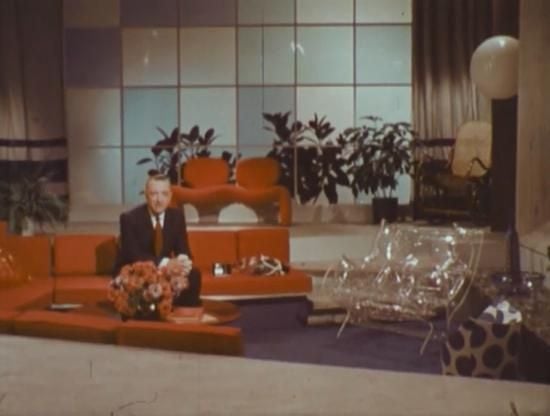
Living Room of 2001
The living room of the future is a place of push-button luxury and a mid-century modern aesthetic. The sunken living room may feature inflatable furniture and disposable paper kids’ chairs, but Cronkite assures us that there’s no reason the family of the future couldn’t have a rocking chair — to remind us that “both the present and the future are merely extensions of the past.”
Once inside we might find ourselves in a glass enclosure where the lint and dirt we’ve accumulated during our trip is removed electrostatically. Now we step into the living room. What will the home of the 21st century look like inside? Well, I’m sitting in the living room of a mock-up of the home of the future, conceived by Philco-Ford and designed by Paul McCobb. This is where the family of the 21st century would entertain guests. This room has just about everything one would want: a big (some might say too big) full color 3D television screen, a stereo sound system that could fill the room with music, and comfortable furniture for relaxed conversation.
If that living room looks familiar it may be because it’s the same house from the Internet-famous short film “1999 A.D.” produced in 1967 (often mistakenly dated as 1969, which would make the moon landing stuff less impressive) and starring a young Wink Martindale.
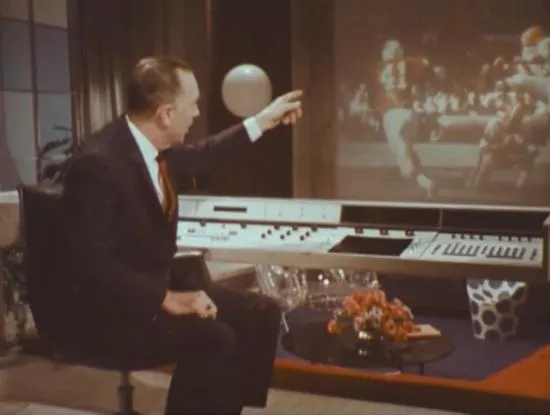
Cronkite explains that a recent government report concludes that Americans of the year 2000 will have a 30-hour work week and month-long vacations “as the rule.” He goes on to tell viewers that this will mean much more leisure time for the average person:
A lot of this new free time will be spent at home. And this console controls a full array of equipment to inform, instruct and entertain the family of the future. The possibilities for the evening’s program are called up on this screen. We could watch a football game, or a movie shown in full color on our big 3D television screen. The sound would come from these globe-like speakers. Or with the push of a button we could momentarily escape from our 21st century lives and fill the room with stereophonic music from another age.
Home Office of 2001
Later, Cronkite takes us into the home office of the future. Here the newspaper is said to be delivered by satellite, and printed off on a gigantic broadsheet printer so that the reader of the future can have a deadtree copy.
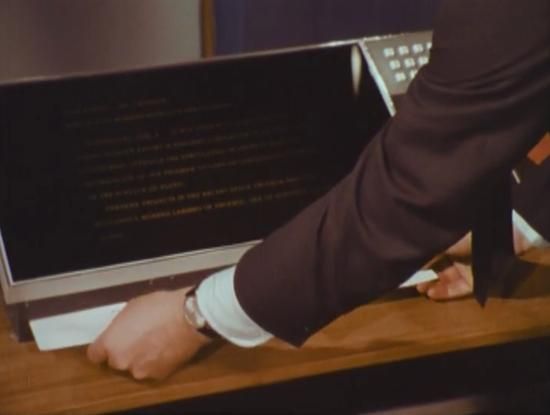
This equipment here will allow to carry on normal business activities without ever going to an office away from home.
This console provides a summary of news relayed by satellite from all over the world. Now to get a newspaper copy for permanent reference I just turn this button, and out it comes. When I’ve finished catching up on the news I might check the latest weather. This same screen can give me the latest report on the stocks I might own. The telephone is this instrument here — a mock-up of a possible future telephone, this would be the mouthpiece. Now if I want to see the people I’m talking with I just turn the button and there they are. Over here as I work on this screen I can keep in touch with other rooms of the house through a closed-circuit television system.
With equipment like this in the home of the future we may not have to go to work, the work would come to us. In the 21st century it may be that no home will be complete without a computerized communications console.
One of the more interesting gadgets in the office of the future that we can clearly see but Cronkite never addresses is the “electronic correspondence machine” of the future, otherwise known as the “home post office.” In the film “1999 A.D.” we see Wink Martindale’s character manipulating a pen on the machine, which allows for “instant written communication between individuals anywhere in the world.”
Kitchen of 2001
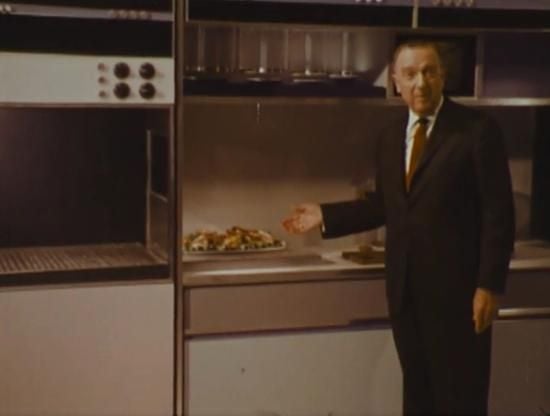
The kitchen of the future includes plastic plates which are molded on-demand, a technology that up until just a few years ago must have seemed rather absurd. With the slow yet steady rise of home 3D printers this idea isn’t completely ridiculous, though we still have quite a ways to go.
After dinner, the plates are melted down, along with any leftover food and re-formed for the next meal. It’s never explained why the molding and re-molding of plates would be any easier or more efficient than simply allowing the machine to just wash the dishes. But I suppose a simple dishwasher wouldn’t have seemed terribly futuristic to the people of 1967.
This might be the kitchen in the home of the future. Preparation of a meal in the 21st century could be almost fully automatic. Frozen or irradiated foods are stored in that area over there.
Meals in this kitchen of the future are programmed. The menu is given to the automatic chef via typewriter or punched computer cards. The proper prepackaged ingredients are conveyed from the storage area and moved into this microwave oven where they are cooked in seconds. When the meal is done the food comes out here. When the meal is ready, instead of reaching for a stack of plates I just punch a button and the right amount of cups and saucers are molded on the spot.
When I’ve finished eating, there will be no dishes to wash. The used plates will be melted down again, the leftovers destroyed in the process and the melted plastic will be ready to be molded into clean plates when I need them next.
Robot Servants of 2001
Later in the program Cronkite takes us to the research laboratory of London’s Queen Mary College where we see robots in development. Cronkite interviews Professor M. W. Thring about the future of household robotics.
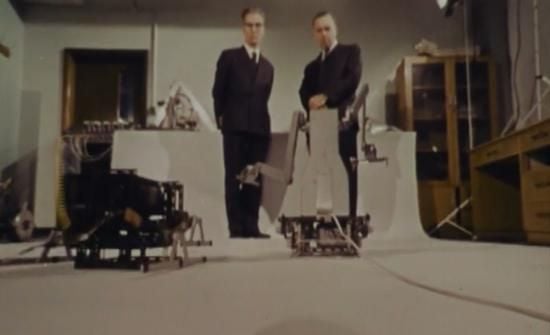
Cronkite assures us that the robots are not coming to take over the world, but instead to simply make us breakfast:
Robots are coming. Not to rule the world, but to help around the house. In the home of 2001 machines like these may help cook your breakfast and serve it too. We may wake up each morning to the patter of little feet — robot feet.
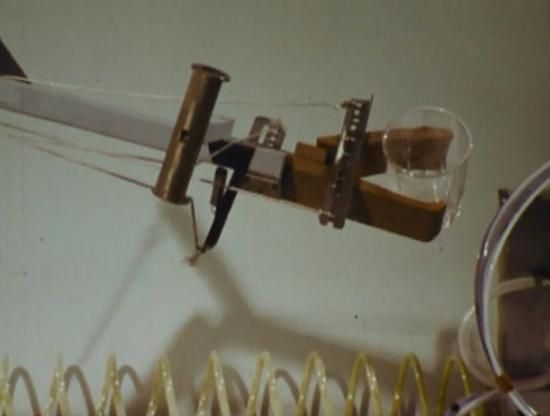
During the interview, the professor addresses one of the most important questions of the futuristic household robot: will it look like a human?
CRONKITE: Professor Thring, what are these?
THRING: These are the first prototypes of small scale models of the domestic housemaid of the future.
CRONKITE: The domestic housemaid of the future?
THRING: Yes, the maid of all work. To do all the routine work of the house, all the uninteresting jobs that the housewife would prefer not to do. You also give it instructions about decisions — it mustn’t run over the baby and things like that. And then it remembers those instructions and whenever you tell it to do that particular program it does that program.
CRONKITE: What is the completed machine going to look like? Is it going to look like a human being?
THRING: No. There’s no reason at all why it should look like a human being. The only thing is it’s got to live in a human house and live in a human house. It’s got to go through doors and climb up stairs and so on. But there’s no other reason why it should look like a human being. For example, it can have three or four hands if it wants to, it can have eyes in its feet, it can be entirely different.
Thring explains that the robot would put itself away in the cupboard where it would also recharge itself whenever it needed to do so — not unlike a Roomba today, or the automatic push-button vacuum cleaners of “The Jetsons,” which first aired just five years earlier.
I first saw this program many years ago while visiting the Paley Center for Media in New York. I asked Skip over at AV Geeks if he had a copy and it just so happens he did. He digitized it and released it as a DVD that’s now available for purchase, called Future Is Not As Good As It Used To Be. Many thanks to Skip for digging out this retro-futuristic gem. And if anyone from CBS is reading this, please release “The 21st Century” online or with a DVD box set. Cronkite’s show is one of the greatest forward-looking artifacts of the 20th century.
/https://tf-cmsv2-smithsonianmag-media.s3.amazonaws.com/accounts/headshot/matt-novak-240.jpg)


/https://tf-cmsv2-smithsonianmag-media.s3.amazonaws.com/accounts/headshot/matt-novak-240.jpg)